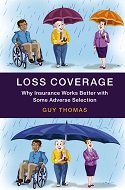Loss coverage
From a public policy perspective, insurance works better with some adverse selection.
Under adverse selection, restrictions on insurance risk classification (e.g genetic tests, gender, big data) may lead to a rise in average price and a fall in numbers insured (both usually seen as disadvantages). But as a matter of simple arithmetic, they also lead to in a shift in coverage towards higher risks - the 'right ' risks, the people who need insurance most. If this shift in coverage is large enough, it can more than out-weigh the fall in numbers insured, so that expected population losses compensated by insurance rises - that is, loss coverage rises.
Three-minute version: here.
Alternative versions: for actuaries, for economists, for lawyers, for general readers.
Videos: Example (5 mins); Objections; Youtube channel.
Teaching & presentation materials (free use, no attribution necessary): a one-page graphic; a 10-minute lecture segment ; a list of references.
Other stuff: book, journal papers, articles and talks.
Main publications:
BOOK: Loss coverage: why insurance works better with some adverse selection(2022) The book is now often less than GBP 10 on Amazon.
Why insurers are wrong about adverse selection
Written for lawyers full text open access
Insurance loss coverage and social welfare
Reconciliation of loss coverage to utilitarian concepts of social welfare full text open access
Insurance loss coverage and demand elasticities.
(Insurance: Mathematics & Economics, 2018)
General results for any downward-sloping insurance demand function
full text open access
Insurance loss coverage under restricted risk classification: the case of iso-elastic demand
(ASTIN Bulletin, 2016)
Comprehensive analysis for this demand function
pdf (29 pages)
Loss coverage in insurance markets: why adverse selection is not always a bad thing
Short version for a conference pdf (17 pages)
This paper was awarded a prize in June 2015 by
the International Actuarial Association!
(ASTIN Bulletin, 2009)
Models of community rating using the loss coverage concept pdf (25 pages)
Loss coverage as a public policy objective for risk classification schemes
(Journal of Risk and Insurance, 2008)
The first full publication of the idea
pdf (21 pages)
Some novel perspectives on risk classification
(Geneva Papers on Risk & Insurance, 2007)
An inchoate version of loss coverage (in a broader paper, also covering psychological and legal perspectives)
pdf (28 pages)
Other related publications (mainly genetics and insurance):
Genetics and insurance in the United Kingdom 1995-2010: the rise and fall of scientific discrimination(New Genetics & Society, 2012)
Actuarial ideology and moral panic concerning genetics and insurance pdf (20 pages)
Background article on genetics and insurance
(Encylopaedia of Applied Ethics, 2nd ed., Elsevier, 2011)
pdf (14 pages)
Genetics and insurance: an actuarial
perspective with a difference
(Reply to Human Genetics Commission consultation, 2001)
An even earlier version from 2001: "...self-selection is at first order a positive
phenomenom..." (pp4-5)
pdf (15pages)
Some history:
My first paper on genetics and insurance
was published in 1997 (see 1). Over
the next several years around the millenium, I consistently argued that insurance companies
should not be allowed to ask questions about genetic test
results
(
– unnecessary deaths arising from reduced uptake of clinically useful tests;
– disadvantaging and disparagement of individuals by genetic identity, akin to racial discrimination;
– insidious normalisation of discrimination in employment and other social contexts;
– infringement of privacy;
– 'compulsory consent' to testing, eroding autonomy and the 'right not to know.'
There also appeared to be no realistic prospect of any material harm to the financial stability of insurers if their access to tests was banned. The remote possibility that this might one day change could be addressed if and when it arose.
Most actuaries and many others disagreed with me at the time, I believe largely because actuarial ideology suggesting the necessity or desirability of genetic discrimination distorted their view of the evidence. I argued at the time that this ideology was malign (see eg 10, 11) ; after another decade of evidence, it now looks increasingly ridiculous.
The ideology that genetic discrimination was necessary and/or desirable in private insurance led to the UK government establising a Genetics and Insurance Committee (GAIC) along the lines originally suggested by the Association of British Insurers. GAIC was designed to legitimise genetic discrimination, by approving applications from insurers to use genetic tests for insurance purposes. I criticised this concept on many occasions (see eg 12, 13, 14).
The criteria for GAIC approval were very favourable to insurers: essentially a test could be approved if it could be reliably shown to be of some commercial value to insurers. However, because of the lack of credible evidence, GAIC did not progress as the insurers or government envisaged. Over a period of 10 years only one application (for Huntington's disease) received approval. In 2009, the government announced that GAIC would be disbanded.
Archive of this page:
My older notes on genetic discrimination in insurance are retained on a separate page.
Old page on genetic discrimination and insurance Various notes from 2000 to 2009


